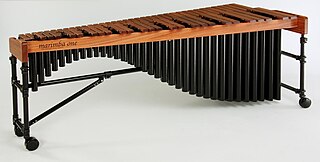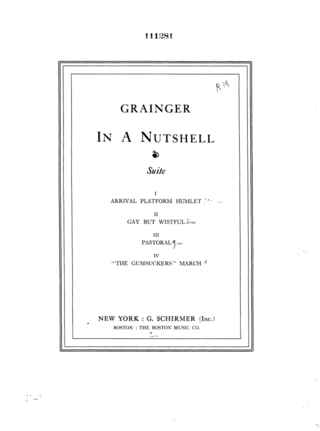
A percussion instrument is a musical instrument that is sounded by being struck or scraped by a beater including attached or enclosed beaters or rattles struck, scraped or rubbed by hand or struck against another similar instrument. Excluding zoomusicological instruments and the human voice, the percussion family is believed to include the oldest musical instruments. In spite of being a very common term to designate instruments, and to relate them to their players, the percussionists, percussion is not a systematic classificatory category of instruments, as described by the scientific field of organology. It is shown below that percussion instruments may belong to the organological classes of idiophone, membranophone, aerophone and chordophone.

The xylophone is a musical instrument in the percussion family that consists of wooden bars struck by mallets. Each bar is an idiophone tuned to a pitch of a musical scale, whether pentatonic or heptatonic in the case of many African and Asian instruments, diatonic in many western children's instruments, or chromatic for orchestral use.

The marimba is a musical instrument in the percussion family that consists of wooden bars that are struck by mallets. Below each bar is a resonator pipe that amplifies particular harmonics of its sound. Compared to the xylophone, the marimba has a lower range. Typically, the bars of a marimba are arranged chromatically, like the keys of a piano. The marimba is a type of idiophone.

The vibraphone is a percussion instrument in the metallophone family. It consists of tuned metal bars and is typically played by using mallets to strike the bars. A person who plays the vibraphone is called a vibraphonist,vibraharpist, or vibist.

The glockenspiel or bells is a percussion instrument consisting of pitched aluminum or steel bars arranged in a keyboard layout. This makes the glockenspiel a type of metallophone, similar to the vibraphone.

The xylorimba is a pitched percussion instrument similar to an extended-range xylophone with a range identical to some 5-octave celestas or 5-octave marimbas, though typically an octave higher than the latter. Despite its name, it is not a combination of a xylophone and a marimba; its name has been a source of confusion, as many composers have called for a 'xylorimba', including Alban Berg, Pierre Boulez and Olivier Messiaen, but for parts requiring only a four-octave xylophone. However, Pierre Boulez wrote for two five-octave xylorimbas in Pli selon pli.

Steve Reich and Musicians, sometimes credited as the Steve Reich Ensemble, is a musical ensemble founded and led by the American composer Steve Reich. The group has premiered and performed many of Reich's works both nationally and internationally. In 1999, Reich received a Grammy Award for "Best Small Ensemble Performance " for the ensemble's performance of Music for 18 Musicians.
Orchestral percussion refers to the various percussion instruments used in an orchestral setting. It may also refer to the act of playing such instruments in an orchestral style. Many music schools and conservatories offer training for musicians interested in developing their skills as orchestral percussionists. Typically, an orchestral percussionist does not specialize in one particular instrument. Although there is no exhaustive list of all instruments that an orchestral percussionist must be able to play, there are particular instruments that are frequently used in the orchestral repertoire. This includes timpani, snare drum, bass drum, xylophone, glockenspiel, triangle, cymbals, and tambourine.

Elstree Calling is a 1930 British comedy musical film directed by Adrian Brunel and Alfred Hitchcock at Elstree Studios.

Stuart Saunders Smith was an American composer and percussionist. After having studied composition and music theory at three music institutions, Smith was currently based in Vermont, United States, with his wife Sylvia. He produced almost 200 compositions, half of which were written for percussion instruments with a focus on the vibraphone.
Clair Omar Musser (1901–1998) was a marimba virtuoso, a conductor and promoter of marimba orchestras, a composer, a teacher, a designer of keyboard percussion instruments, an inventor, and an engineer for Hughes Aircraft.
The Green Brothers Novelty Band was a recording ensemble active from 1918 to 1939. The group was led by brothers Joe Green (1892–1939) and George Hamilton Green (1893–1970), xylophone artists along with younger brother Lew Green (1909–1992), on banjo, from Omaha, Nebraska.

A keyboard percussion instrument, also known as a bar or mallet percussion instrument, is a pitched percussion instrument arranged in the same pattern as a piano keyboard and most often played using mallets. While most keyboard percussion instruments are fully chromatic, keyboard instruments for children, such as ones used in the Orff Schulwerk, may be diatonic or pentatonic.

The flapamba is a musical instrument in the percussion family. It consists of tuned wooden bars pinched on one side over the node and mounted over resonator boxes. Sliding the bars slightly forward or backward affects their tuning. Unlike the marimba or xylophone, the sound is not as focused tonally. It is a bit more percussive, sounding closer to tuned log drums.
Emmanuel Séjourné is a French composer and percussionist, and head of percussion at the Conservatoire de Strasbourg. His music is influenced by Western classical music and by popular music.

Samuel Herbert Herman was an American xylophonist at NBC radio and television.
Tatsuo Sasaki is a Japanese percussionist, playing timpani, xylophone and marimba. He became a naturalized American citizen and lives in San Diego, California.
Morris Goldenberg was an American percussionist, music teacher, and method book author. He wrote several books on orchestral snare drumming, mallet percussion, and timpani. He is a member of the Percussive Arts Society Hall of Fame.
Haskell Warren Harr was an American percussionist, composer, and bandleader. He was active for over sixty years in various fields of music, from playing in vaudeville radio shows, directing military bands, and serving as the inaugural professor of percussion at the VanderCook College of Music. He is best known for his method books, particularly Drum Method which was published in two volumes in the late 1930s. His method books have been used by several notable percussionists, including Steve Reich and Terry Bozzio.

In a Nutshell is a musical composition by Percy Aldridge Grainger for orchestra, piano, and Deagan percussion instruments. The suite, published in 1916, is made up of four movements: "Arrival Platform Humlet", "Gay But Wistful", "Pastoral", and "The Gum-Suckers March". Grainger later made versions for both solo piano and piano duo. It is described as one of the early modernist works of Grainger.













